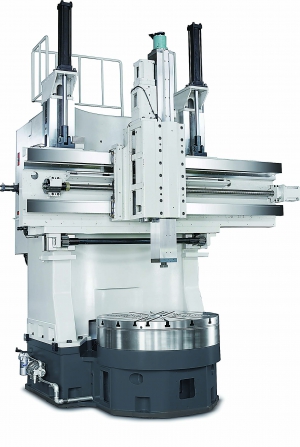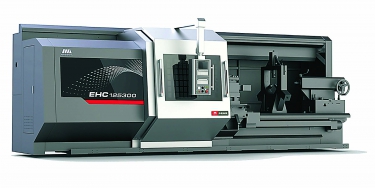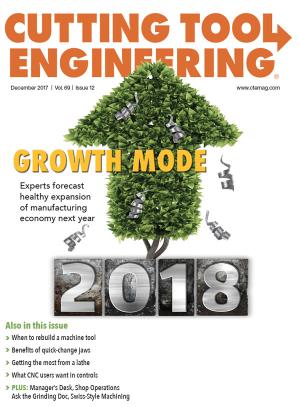Look in a couple of nooks in the machine tool market and you’ll find what appear to be bargains for those buying big.
Take machines that produce large turned parts. Firms can have trouble outsourcing such parts because job shops can’t find affordable turning centers to do the work, according to Jerry McCarty, COO of SMTCL USA Inc., City of Industry, Calif.
“There really never was a job shop machine that would do large turning,” McCarty said, adding that large turning machines typically cost $400,000 or more. His company offers two new horizontal turning centers priced under $300,000—“30 percent cheaper than what people normally pay for this kind of machine,” he said.

Essential parts of the MVL-16 VTL. According to Momentum, all MVL models offer oversize rams and other components, as well as more horsepower and machine mass than more expensive competitors. Image courtesy of Momentum Machine Tool.
An even less affordable option has been to shell out $1 million or more for machines that can also mill, McCarty noted. “Our products are filling a niche for job shops doing just one operation—turning—on very large products.”
Priced at $269,000, SMTCL’s EHC125300 is a CNC horizontal lathe that can turn out parts up
to 3m (118") long. Standard features of the 44,000-lb. (19,958kg) machine include a 1,000mm (39.4") chuck, 8-position turret, steady rest, hydraulic tailstock and chip conveyor.
SMTCL’s other new machine, the EHC125500, costs $20,000 more than the EHC125300 but can produce parts up to 5m (197") long and weighing as much as 11,000 lbs. (4,990kg).
Though the parts are big, McCarty said, the new turning centers offer accuracy that is often measured in microns.
But tolerance stackup can occur if the parts must be moved to a different machine for drilling or other secondary operations that require milling. This is the Achilles’ heel of the new machines compared with more expensive milling-capable offerings, McCarty said.
Like job shops searching in vain for affordable turning centers, customers of Jack Butts’ machine tool distributorship often complained about their inability to find a heavy-duty vertical turning lathe at what they regarded as a fair price. The problem, according to Butts, was that major machine builders weren’t showing sufficient interest in the VTL category.
The result was a VTL market with few major suppliers, high prices and inferior product quality, according to Butts.
So in 2014, Butts and a couple of partners founded Momentum Machine Tool Co. to give customers the heavy-duty but moderately priced VTLs they had long been asking for. Momentum is headquartered in Houston, but, after founding the company, the partners purchased a factory in Taichung, Taiwan, the world’s largest source of VTLs. This factory had been manufacturing a product that was closest to meeting Momentum’s VTL design criteria. Today, the factory turns out Momentum’s MVL-series VTLs, which meet the needs of the company’s Houston-area customers and are also becoming increasingly popular outside its home territory, according to Butts.
What’s the appeal of the MVL? “In terms of specifications, there is just no such thing as a machine that out-specs the MVL,” said John Boland, president of Spartan Precision Machinery/Momentum USA, Houston, which was established to import Momentum products into North America.

The new EHC125300 horizontal turning center from SMTCL is designed to be an economical option for job shops turning large parts. Image courtesy of SMTCL USA.
For example, a video on the Spartan website reports that the 78,000-lb. (35,380kg) MVL-16 has enough mass to provide the needed resistance to cutting forces, operates at 75 hp (55.95kW) to speed up metal removal and can turn parts weighing as much as 22,000 lbs. (9,979kg).
As far as competition goes, according to the video, there are higher-priced VTLs on the market that weigh half or two-thirds of what an MVL does, operate at just 60 hp (44.76kW) and can handle parts weighing no more than 17,000 lbs. (7,711kg).
Compared with an MVL, a competitive VTL offering might be “literally half the machine if you melt it down,” Boland said. “Nonetheless, a customer could pay $250,000 more for it because it’s built in Japan and there is a 35-year history that says that Japanese machines are well-built.”
If you’re a cost-conscious VTL shopper, however, Momentum’s more-machine-for-less pitch may be hard to resist.
Related Glossary Terms
- centers
centers
Cone-shaped pins that support a workpiece by one or two ends during machining. The centers fit into holes drilled in the workpiece ends. Centers that turn with the workpiece are called “live” centers; those that do not are called “dead” centers.
- chuck
chuck
Workholding device that affixes to a mill, lathe or drill-press spindle. It holds a tool or workpiece by one end, allowing it to be rotated. May also be fitted to the machine table to hold a workpiece. Two or more adjustable jaws actually hold the tool or part. May be actuated manually, pneumatically, hydraulically or electrically. See collet.
- computer numerical control ( CNC)
computer numerical control ( CNC)
Microprocessor-based controller dedicated to a machine tool that permits the creation or modification of parts. Programmed numerical control activates the machine’s servos and spindle drives and controls the various machining operations. See DNC, direct numerical control; NC, numerical control.
- gang cutting ( milling)
gang cutting ( milling)
Machining with several cutters mounted on a single arbor, generally for simultaneous cutting.
- lathe
lathe
Turning machine capable of sawing, milling, grinding, gear-cutting, drilling, reaming, boring, threading, facing, chamfering, grooving, knurling, spinning, parting, necking, taper-cutting, and cam- and eccentric-cutting, as well as step- and straight-turning. Comes in a variety of forms, ranging from manual to semiautomatic to fully automatic, with major types being engine lathes, turning and contouring lathes, turret lathes and numerical-control lathes. The engine lathe consists of a headstock and spindle, tailstock, bed, carriage (complete with apron) and cross slides. Features include gear- (speed) and feed-selector levers, toolpost, compound rest, lead screw and reversing lead screw, threading dial and rapid-traverse lever. Special lathe types include through-the-spindle, camshaft and crankshaft, brake drum and rotor, spinning and gun-barrel machines. Toolroom and bench lathes are used for precision work; the former for tool-and-die work and similar tasks, the latter for small workpieces (instruments, watches), normally without a power feed. Models are typically designated according to their “swing,” or the largest-diameter workpiece that can be rotated; bed length, or the distance between centers; and horsepower generated. See turning machine.
- milling
milling
Machining operation in which metal or other material is removed by applying power to a rotating cutter. In vertical milling, the cutting tool is mounted vertically on the spindle. In horizontal milling, the cutting tool is mounted horizontally, either directly on the spindle or on an arbor. Horizontal milling is further broken down into conventional milling, where the cutter rotates opposite the direction of feed, or “up” into the workpiece; and climb milling, where the cutter rotates in the direction of feed, or “down” into the workpiece. Milling operations include plane or surface milling, endmilling, facemilling, angle milling, form milling and profiling.
- milling machine ( mill)
milling machine ( mill)
Runs endmills and arbor-mounted milling cutters. Features include a head with a spindle that drives the cutters; a column, knee and table that provide motion in the three Cartesian axes; and a base that supports the components and houses the cutting-fluid pump and reservoir. The work is mounted on the table and fed into the rotating cutter or endmill to accomplish the milling steps; vertical milling machines also feed endmills into the work by means of a spindle-mounted quill. Models range from small manual machines to big bed-type and duplex mills. All take one of three basic forms: vertical, horizontal or convertible horizontal/vertical. Vertical machines may be knee-type (the table is mounted on a knee that can be elevated) or bed-type (the table is securely supported and only moves horizontally). In general, horizontal machines are bigger and more powerful, while vertical machines are lighter but more versatile and easier to set up and operate.
- pitch
pitch
1. On a saw blade, the number of teeth per inch. 2. In threading, the number of threads per inch.
- steady rest
steady rest
Supports long, thin or flexible work being turned on a lathe. Mounts on the bed’s ways and, unlike a follower rest, remains at the point where mounted. See follower rest.
- tolerance
tolerance
Minimum and maximum amount a workpiece dimension is allowed to vary from a set standard and still be acceptable.
- turning
turning
Workpiece is held in a chuck, mounted on a face plate or secured between centers and rotated while a cutting tool, normally a single-point tool, is fed into it along its periphery or across its end or face. Takes the form of straight turning (cutting along the periphery of the workpiece); taper turning (creating a taper); step turning (turning different-size diameters on the same work); chamfering (beveling an edge or shoulder); facing (cutting on an end); turning threads (usually external but can be internal); roughing (high-volume metal removal); and finishing (final light cuts). Performed on lathes, turning centers, chucking machines, automatic screw machines and similar machines.


